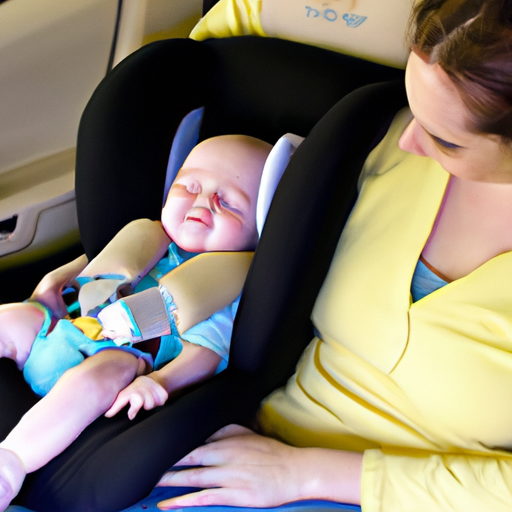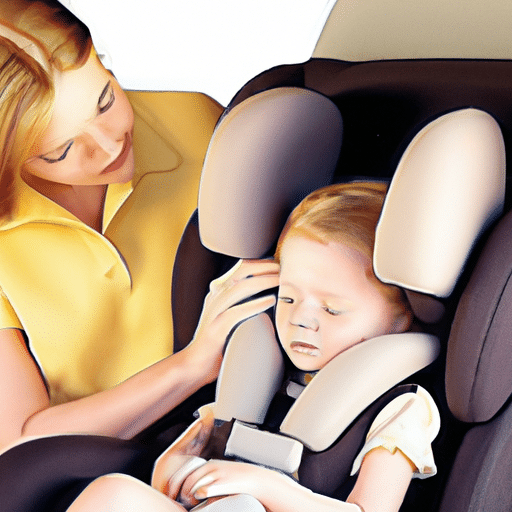Have you ever noticed your baby’s head slumping forward in their car seat? It can be a concern for many parents, as it may not only be uncomfortable for your little one, but it can also pose a risk to their airway and breathing. In this article, we will explore some simple yet effective tips to help you keep your baby’s head properly supported and prevent it from slumping in their car seat, ensuring a safer and more comfortable ride for your precious bundle of joy.
1. Selecting the Right Car Seat for Your Baby
1.1 Choosing the Proper Car Seat Size
When it comes to selecting a car seat for your baby, size matters. You want to ensure that the car seat is appropriate for your baby’s age, weight, and height. There are different types of car seats available, such as infant car seats, convertible car seats, and booster seats. It’s important to choose a car seat that is specifically designed for infants and provides adequate support for their developing bodies.
1.2 Ensuring Proper Car Seat Installation
Once you have chosen the right car seat for your baby, it’s crucial to ensure that it is properly installed in your vehicle. Correct installation is vital for maximum safety and protection. Follow the manufacturer’s instructions carefully and make sure the car seat is securely fastened. If you are unsure about the installation process, you can seek help from a certified child passenger safety technician in your area.
2. Adjusting the Car Seat Angle
2.1 Understanding the Importance of the Car Seat Angle
The angle of the car seat is crucial for your baby’s comfort and safety. It helps to prevent their head from slumping forward, which can restrict their airway and potentially cause breathing difficulties. Maintaining the correct car seat angle ensures that your baby’s head and neck are properly supported, reducing the risk of any head flopping or slumping while they are seated.
2.2 Adjusting the Angle According to the Infant’s Age and Development
As your baby grows and develops, it’s essential to adjust the car seat angle accordingly. Many car seats come with adjustable recline positions to accommodate different stages of development. For newborns, a more reclined position is recommended to provide proper support for their delicate bodies and prevent their heads from falling forward. As your baby gets older and gains more neck control, you can gradually adjust the car seat to a more upright position.

3. Using Additional Supportive Devices
3.1 Understanding the Purpose of Supportive Devices
In some cases, additional supportive devices can be used to ensure that your baby’s head stays in the correct position while in the car seat. These devices are designed to provide extra support and stability, minimizing any head slumping or flopping. However, it’s important to note that not all supportive devices are safe or recommended. It’s crucial to choose the right device and use it properly to avoid any potential risks.
3.2 Selecting the Right Supportive Device for Your Baby
When selecting a supportive device for your baby, it’s important to choose one that is specifically designed for car seat use and recommended by reputable child safety organizations. Avoid using bulky or cushion-like devices that can interfere with the proper fit and function of the car seat. Instead, opt for approved headrests, neck supports, or rolled blankets that provide gentle support without compromising safety.
3.3 Using Supportive Devices Properly
Once you have chosen a suitable supportive device, it’s essential to use it correctly. Follow the manufacturer’s instructions and ensure that the device does not interfere with the secure harnessing of your baby in the car seat. It’s crucial to maintain proper positioning of the device to prevent any potential hazards. Regularly check the device for wear and tear and cease using it if it becomes damaged or compromised in any way.
4. Placing the Baby in the Car Seat Correctly
4.1 Positioning the Baby’s Head in the Center of the Car Seat
To minimize any head slumping or flopping, ensure that your baby’s head is positioned in the center of the car seat. This will provide optimal support to their head and neck, reducing the risk of any uncomfortable or unsafe positioning. Gently adjust your baby’s head so that it rests in the middle of the headrest, ensuring a balanced and secure fit.
4.2 Buckling the Seat Belts Properly
Once you have positioned your baby in the car seat, it’s important to buckle the seat belts correctly. Ensure that the harness straps are snug but not too tight, allowing your baby to breathe comfortably while still maintaining a secure fit. Check that the chest clip is at armpit level to provide proper positioning and prevent any slumping or sliding down in the seat.

5. Avoiding Bulky Clothing or Blankets
5.1 Understanding the Risks of Bulky Clothing or Blankets
While it may be tempting to bundle your baby up in thick layers or blankets during colder weather, it’s important to be aware of the potential risks this can pose in a car seat. Bulky clothing or blankets can compress and create gaps between your baby’s body and the car seat, compromising the effectiveness of the harness and potentially leading to improper positioning or even ejection in case of an accident.
5.2 Dressing Your Baby Appropriately for Car Seat Safety
To ensure optimal safety and comfort, dress your baby in thin, snug-fitting layers. Use a blanket or a car seat cover designed specifically for car seats to provide warmth without compromising the harness’s integrity. Remember to remove any unnecessary layers or blankets before securing your baby in the car seat to maintain a proper and secure fit.
6. Taking Regular Breaks During Long Drives
6.1 Understanding the Importance of Breaks for Your Baby’s Comfort
Long drives can be exhausting for both you and your baby. Taking regular breaks during your journey is essential to ensure your baby’s comfort and reduce the risk of any discomfort or agitation. Frequent breaks allow you to check on your baby, change their position, or provide feeding or diapering if needed.
6.2 Planning Breaks Strategically
When planning your long drive, schedule regular breaks at convenient intervals. Aim for breaks every 1-2 hours to give your baby a chance to stretch, move around, and have a change of scenery. Find safe rest areas or designated stops along your route where you can park and attend to your baby’s needs. Planning breaks strategically not only benefits your baby but also helps you stay refreshed and focused on the road.

7. Using Rear-Facing Car Seats for as Long as Possible
7.1 Knowing the Benefits of Rear-Facing Car Seats
Rear-facing car seats are considered the safest option for infants and young children. They provide crucial support for a baby’s developing head, neck, and spine, as well as offer excellent protection in the event of a collision. Being seated in a rear-facing position helps distribute the crash forces more evenly throughout the body, minimizing the impact on your baby’s vulnerable neck and head.
7.2 Adhering to Safety Recommendations for Rear-Facing Car Seats
To ensure optimal safety, it is recommended to keep your baby in a rear-facing car seat for as long as possible, following the guidelines from the car seat manufacturer and safety organizations. Many car seats now offer extended rear-facing options that accommodate larger infants and toddlers. Keep in mind that it’s important to transition to a forward-facing car seat only when your child has reached the height and weight limits specified by the car seat’s manufacturer.
8. Minimizing Vibrations and Sudden Movements
8.1 Avoiding Bumpy Roads and Rough Driving
Excessive vibrations and sudden movements can increase the risk of your baby’s head slumping or flopping in the car seat. Try to avoid driving on bumpy roads or engaging in rough driving maneuvers that can cause the car seat to jolt or shake. Opt for smoother routes and drive defensively to minimize any potential discomfort or unexpected movements.
8.2 Reducing Unnecessary Movements in the Car
To further minimize the risk of sudden head movements, it’s important to ensure that the car seat is properly secured and installed in your vehicle. Use the seat belt or LATCH system correctly and tighten it according to the manufacturer’s instructions. Limit any unnecessary movements within the car, such as quick braking or accelerating, to provide a smoother and more stable environment for your baby.

9. Regularly Checking and Adjusting the Baby’s Head Position
9.1 Understanding the Importance of Regular Monitoring
Regularly checking and adjusting your baby’s head position in the car seat is crucial for maintaining their safety and comfort. Babies commonly shift and move their heads during car rides, making it important to monitor their position and make necessary adjustments to prevent any slumping or flopping that could potentially obstruct their airway.
9.2 Adjusting the Head Position as Needed
During longer car rides, it’s a good idea to check on your baby’s head position periodically. If you notice any signs of slumping or forward head movement, gently readjust their head to ensure it is properly aligned with their body and supported by the car seat. Pay attention to any discomfort or restlessness your baby may display, as this could be an indication that their head position needs to be adjusted.
10. Seeking Professional Advice if Concerns Persist
10.1 Consulting with a Pediatrician or Child Passenger Safety Technician
If you have followed all the recommended guidelines and techniques and are still experiencing concerns about your baby’s head slumping in the car seat, it’s important to seek professional advice. Consult with your pediatrician or a certified child passenger safety technician who can provide expert guidance and assess any potential underlying issues that may be affecting your baby’s positioning or comfort.
10.2 Exploring Potential Underlying Issues
There could be various factors contributing to your baby’s head slumping in the car seat, including medical conditions or developmental challenges. A medical professional or specialist can help identify and address any underlying issues that may be affecting your baby’s head control or positioning. By exploring these potential factors, you can gain valuable insights and access appropriate support or interventions if necessary.
By following these comprehensive guidelines, you can ensure that your baby’s head remains properly supported and positioned in the car seat, promoting safety and comfort during every journey. Remember to always stay up to date with the latest recommendations, consult trusted resources, and prioritize your baby’s well-being when it comes to car seat safety.






